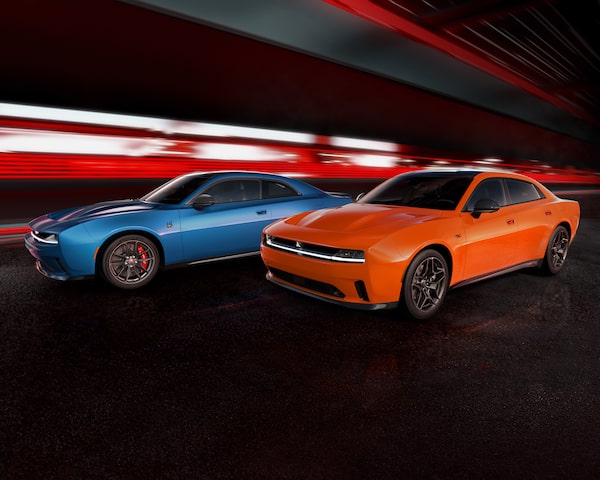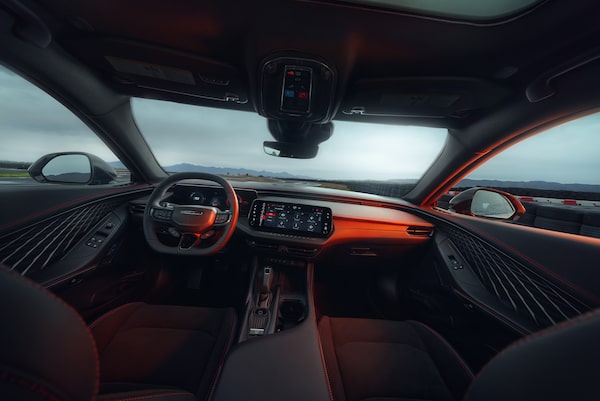
Initially, the Charger Daytona will be available as a coupe, in two power levels: 496 and 670 horsepower.Stellantis/Courtesy of manufacturer
In one of the more bizarre car launches in recent memory, Dodge’s chief executive officer Tim Kuniskis pitched the brand’s first electric muscle car – the Charger Daytona, which will hit the road this summer – as an anti-establishment champion.
He tried to position this made-in-Canada EV as an act of rebellion, a way to fight the system and outfox regulators.
“This is not the electric car that they want the brotherhood to have,” Kuniskis said in a pre-recorded Back To The Future inspired mini-movie made for the launch of his company’s EV. “This is a Dodge. This is an electric muscle car that will make the rule makers, the suits and the lawyers wish they hadn’t had a kale smoothie for lunch when they launch this thing.”
In reality, U.S. regulators are likely applauding the unveiling of yet another homegrown EV made possible by a series of protectionist policy measures and consumer tax credits enacted under the Biden administration.
The “brotherhood” Kuniskis mentions is the “brotherhood of muscle,” a marketing term Dodge uses to refer to its owners.
“Right now we’re under attack. Your legacy is under attack,” a time-travelling Kuniskis told Dodge’s founders in the short film. “We need your help, spiritually of course, to fight the system.”
The “spiritually” caveat feels like something the corporate lawyers made them add.
Here are some other things Kuniskis said during the unveiling of Dodge’s upcoming coupe and sedan:
- “Most people think electric cars are supposed to save the planet. Electric cars are supposed to be green and politically correct.”
- “They told us we couldn’t sell HEMIs, but they never told us that we had to be boring and slow.”
- “So we took the rules, found the grey areas, and used them against them to build a muscle car, to build a Dodge muscle car, and slide it under the wire that the regulators threw down in front of us like spike strips on the highway.”
EVs are politically correct? Elon Musk and his Cybertruck are proof EVs aren’t just for Democrats.
EVs are supposed to be slow? Has Kuniskis driven other EVs? Ford’s F-150 Lightning pickup can get to 100 kilometres an hour in around four seconds. That is not slow.
How is this not the electric car “they” wanted the “brotherhood” to have? Who is “they?”
And the idea that regulators somehow tried to impede or stop the development of an electric muscle car by throwing down metaphorical spike-strips is absurd. Regulators seem hell-bent on doing the opposite, on accelerating the development of any and all electric cars made in North America.
When asked who he’s really speaking to in this short film, Kuniskis said, “we’re doing [an EV] totally different than we see the industry doing it, which is what [the company’s founders] did. If you think about what their history was, that’s why I say, ‘do you want to be part of this system? Or do you want to fight the system?’”
Asked by a reporter who the system refers to, he said the idea was to make a cool video and “it’s not as deep as you want it to be.”
Still, it’s bizarre to pitch an EV as somehow not politically correct, as anti-woke or anti-establishment. For one thing, it’s just a car. For another, there’s nothing unlawful about the Dodge Charger Daytona. Besides, when car companies do try to evade regulators and break the rules (as in the diesel-emissions cheating scandal) they don’t brag about it in news conferences.

The interior of the Dodge Charger Daytona.Stellantis/Courtesy of manufacturer
Either this anti-kale rhetoric is just a marketing ploy aimed at getting red-state anti-EVers to buy an EV, or the death of the brand’s beloved gas-guzzling V8 muscle cars has really thrown the muscle car “brotherhood” into an existential crisis.
Muscle cars, historically, were all about affordable straight-line speed. But what’s their reason for being when even your average EV is decently quick and a four-door Tesla can outrun nearly everything on four wheels? Until recently, Dodge’s muscle cars still had the biggest, thirstiest, loudest V8 engines and real manual gearboxes. Take away the V8 and the manual gearbox and you’re left with what will likely be a relatively expensive electric sports car with retro muscle-car styling. (It will still be loud though. Dodge put noise-making speakers on the outside of the Charger Daytona.)
Beyond the rhetoric, the car itself actually seems pretty good, at least on paper. It’ll be available initially as a coupe, in two power levels: 496 and 670 horsepower. (Those figures include a temporary 40-horsepower, 15-second boost available at the push of a steering-wheel button.) Range estimates for those cars are 510 kilometres for the lower-power model and 418 kilometres if you want the full 670. Then, beginning in 2025, the Charger Daytona will also be available as an electric sedan with the same powertrains.
For driving enthusiasts, these cars are welcome additions to the small but growing ranks of driver-focused performance EVs, a group that includes the Porsche Taycan, BMW i4, Ford Mustang Mach-E GT, Hyundai Ioniq 5 N and Kia EV6 GT.
If you’re still not sold on the electric Charger Daytona, next year Dodge will introduce a version of the new Charger with a six-cylinder internal combustion engine.
The new Chargers will be built at the company’s Windsor assembly plant, which was retooled earlier this year to produce both EVs and gas-powered vehicles.
Perhaps the only truly controversial thing about the electric Charger Daytona will be its price, which – with standard all-wheel drive and a 100 kilowatt-hour battery pack – is likely to stretch the definition of affordable.
Shopping for a new car? Check out the Globe Drive Build and Price Tool to see the latest discounts, rebates and rates on new cars, trucks and SUVs. Click here to get your price.
 Matt Bubbers
Matt Bubbers